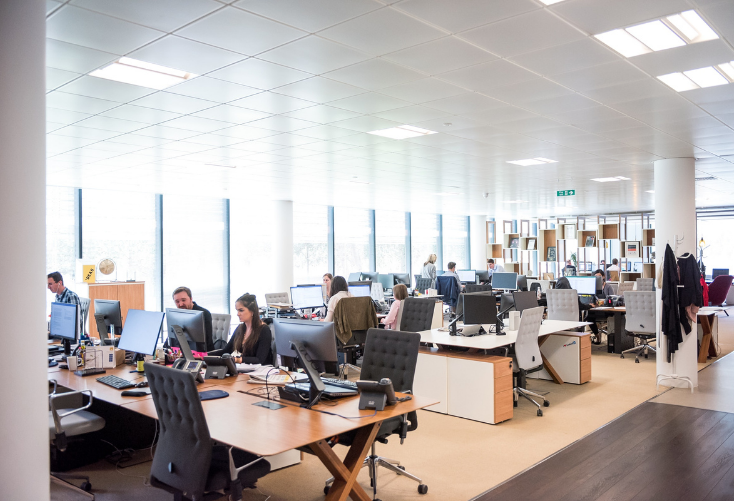Hand selected flexible workspace news from the most reliable sources to keep you ahead of the pack. We find all the latest news, so you don’t have to. Morning and afternoon updates. Stay in the know.
Here’s what you need to know today:
- Digital Integration In The Workplace Is Essential NEW
- Could Be The End Of The Office? NEW
- Employees Miss The Office, But Want To Be Safe NEW
- Increased Flexibility Instills Confidence In Coworking Firms
- Flexibility Could Help With Workplace Equality
- Offices Of The Future Will Still Play An Important Role
Digital Integration In The Workplace Is Essential
A study conducted by NTT and published in their 2019 “Digital Means Business Benchmarking Report” revealed that most organizations understand the importance of digital integration.
The 2021 NTT report “Future Disrupted: 2021 Technology Trends” anticipates that the link between business value and investment will become even more evident over the next year.
This means that IT departments will need to be equipped with the right tools to respond to a company’s needs, or risk falling behind.
Based on a survey of 1,350 decision makers, only 43.3% of respondents said they have integrated new productivity resources. Those who haven’t saw employees using their own personal devices for work-related communication, putting them at risk security attacks.
Even more, 66.9% of companies said it was difficult to identify IT security of business risks when operating remotely.
The report predicts five new technologies that will aid in shaping the digital workplace. These include: all-photonics networks for end-to-end communication; digital twin computing (DTC) for predictive analytics; low-code/no-code platforms that allows employees to create business applications using company data; and quantum and edge computing.
However, many of these technological advancements are not accessible to most organizations at the moment and won’t likely be for at least another three to five years.
“That’s the real digital transformation that I don’t think we’ve contemplated yet,” said Everett Harper, CEO of software engineering firm Truss. “The winners of this will be people who take this seriously, who have a long-term vision, and who rely on their networks of people to help them change their organization.”

Could Be The End Of The Office?
When the oil crisis of 1973 hit, North America saw itself in short supply of gas which hindered people’s ability to get to and from work.
This led to the idea of allowing employees working from home until the conflict was ironed out. Companies like IBM quickly realized that remote working had more benefits than a solution to temporary problems, like being able to expand their talent pool without investing into more office space.
In 2009, 40% of IBM’s employees worked out of an office sparingly, allowing the company to save $100 million annually.
Now, thanks to major advancements in technology, this work policy has become more accessible to other organizations.
However, prior to the pandemic, companies started investing even more money into their workspaces to be equipped with the latest technology and amenities. In 2017, IBM itself revealed it would be bringing 2,600 remote workers back into the office.
As health and safety has come to the forefront of most workers’ priorities, the office is not the best place to be. The pandemic has made physical distancing and frequent sanitation the norm, and the office could easily become a hub for illness if the proper precautions are not taken.
Still, this does not mean this is the end of the office. In fact, the office will continue to play a significant role in nurturing communication and hosting all-hands meetings.

Employees Miss The Office, But Want To Be Safe
Although there is a third wave of COVID-19 cases crashing through the U.S., over half of employees are eager to return to the workplace.
This may be attributed to the fact that workers are better equipped with the knowledge to keep themselves and others protected from the virus, according to Adam Pressman, business segment leader for employee research and engagement at HR consulting firm Mercer.
“We have seen this shift quite a bit over the last six months,” said Pressman. “The data we’ve seen is that the majority of people want to return to work.”
Pressman added that these workers do prefer a hybrid approach through, allowing them to work in the office and remotely when needed.
Additionally, the survey revealed that employees returning to the workplace is contingent upon their employers’ ability to be transparent about how they are keeping them safe. For instance, how often are desks being sanitized? Has everyone been informed about the new policies and procedures?
The Mercer survey found that bathrooms are seen as the biggest health risk of working in-person. A survey from Office Depot back in August found that meeting and conference rooms, as well as common areas were perceived as the biggest health risk of the workspace.
While it is unclear when employees will be able to commit to coming back into the office, they will expect their employer to take extra precautions to keep them safe when they do.

Increased Flexibility Instills Confidence In Coworking Firms
Although the majority of the world is experiencing a second or third wave of COVID-19 cases, coworking operators remain confident about the future of the industry.
According to a new Workthere survey of global providers, 42% of operators are optimistic about the sector’s future, up 40% from July. Even more, over three-fourths of providers said they were optimistic or very optimistic about coworking’s outlook over the next year.
“What we’re seeing as we progress through this pandemic period is that market participants are behaving rationally in the face of uncertainty,” said Ted Skirbunt, national director at Workthere Americas. “Many small- to mid-sized tenants are not renewing traditional leases upon expiration, seeking more flexible solutions, and there are more opportunities out there to secure flexible space at deep discounts to even just a few months ago.”
Another recent report from Colliers revealed that 90% of flexible workspace users anticipate an increase in flexibility within leases, which seems to be a recurring theme that operators are eager to capitalize on.
However, the industry has been facing an uncertain future even prior to the pandemic. In 2019, WeWork’s tumultuous attempt to go public revealed foundational issues for many operators. Now, as millions of people continue to work from home, providers have either had to limit their services or close completely.
In fact, coworking firms contributed 1.2 million square feet of returned office space to landlords in Manhattan since the beginning of the pandemic.
This has led firms to rethink their operational strategies moving forward by focusing on which markets are doing well and others that are struggling.

Flexibility Could Help With Workplace Equality
A recent study has revealed flexible working policies led to a 20% increase in job applications for senior positions from women.
This data came from insurer Zurich UK, which is part of a wider government-backed study, found that applications from women for management positions have grown after it started promoting flexible work hours.
Last year, Zurich became the first company in the UK to market all of its vacancies with the option of part-time, full-time, job share or flexible working.
“Embracing part-time and flexible work is not a silver bullet. But we’ve seen hugely encouraging results, simply by adding six words to our job adverts,” said Steve Collinson, head of HR at Zurich. “By offering roles that fit flexibly around family life, employers could open the floodgates to a much wider pool of untapped talent. This will also help women progress into higher paid jobs whilst fitting other commitments around their careers.”
In addition to the firm seeing a growth in female applications for higher roles, the company also saw a 16% rise in women applying for jobs at various levels.
According to Elizabeth Berridge, Minister for Women, adopting such policies can make it easier for companies to achieve workplace equality and potentially even out the gender pay gap.

Offices Of The Future Will Still Play An Important Role
Around 42% of the U.S. workforce was working from home full time in June this year. This mass migration to remote working positions has completely accelerated changes to the workplace now and in the future.
“Figuring out who will work from home and who will require actual office space, which offices to prune and which to keep, how they will be configured and shared, and precisely where they should be sited requires more strategic thought, analysis, and planning than ever,” wrote professor Richard Florida in the Harvard Business Review (HBR).
One of the main factors of the future of work is a hybrid work arrangement, which would allow employees to split their time between the office and working from home.
This will likely mean an increase in flexible schedules and shared offices, which could lead to decreased office takeup in 2022. In fact, a KPMG survey conducted in August found that 69% of CEOs have plans to downsize their real estate footprint.
Additionally, offices of the future will still play an important role, but will have a rejuvenated purpose. Instead of being a space where employees use for 40 hours each week, they will be used for more collaborative opportunities and to nurture community.
According to Cushman & Wakefield, these offices will also be part of a greater ecosystem of workspaces rather than just one hub. This allows for more flexibility for employees who wish to work closer to their homes and the decentralization of the office.



 Dr. Gleb Tsipursky – The Office Whisperer
Dr. Gleb Tsipursky – The Office Whisperer Nirit Cohen – WorkFutures
Nirit Cohen – WorkFutures Angela Howard – Culture Expert
Angela Howard – Culture Expert Drew Jones – Design & Innovation
Drew Jones – Design & Innovation Jonathan Price – CRE & Flex Expert
Jonathan Price – CRE & Flex Expert















